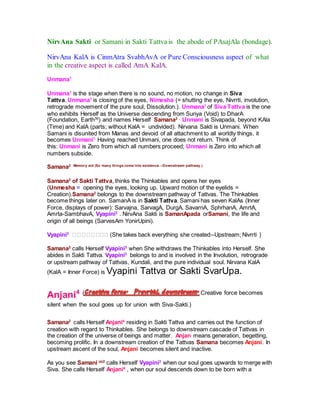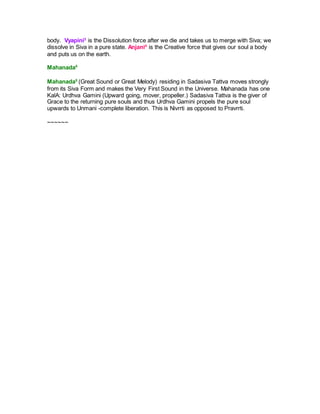This document discusses concepts from Hindu philosophy including Māyā, Śakti, Śiva, and Tattvas. It explains that Māyā is the power that veils consciousness and produces the experience of a limited world. Śakti is the active power or aspect of consciousness, while Śiva is the static aspect. Together they make up Īśvara. The Tattvas are the building blocks or principles that make up the universe, emanating from Śakti. Consciousness takes on different aspects or statuses through Śakti, appearing as both the transcendent Absolute and immanent God or creator.



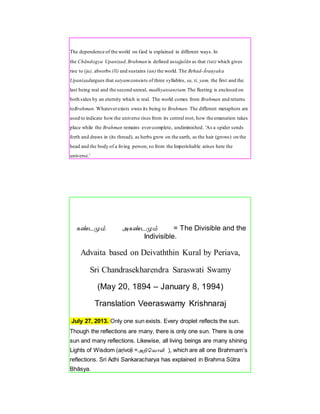

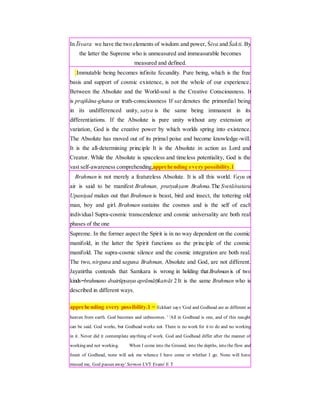






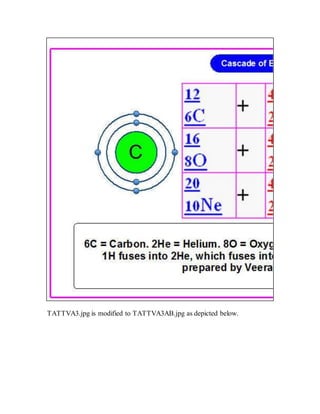

![First there is Void (Singularity) and later Consciousness. Consciousness thinks
the Thinkables and speaks the Speakables, when the thinkable becomes an
audible sound. The Speakables become alphabets, syllables, words....
Remember all this is sound. What is a thinkable? Thinkable is a visual sound
(Example. Generally speaking, God thinks of apple; Apple appears in His
mind's eye; that is visual sound of Apple. The mental sound, Apple, explodes
out of His voice box and becomes an audible sound of "Apple". God thinks and
says the word Apple and the Apple appears before Him. Here you appreciate
God's Will, Thought, and Word in the creation of an Object. (God said, 'Let
there be Light; there was Light.') Once the word is spoken it is articulate sound.
Sound is the origin of Thinkables, Speakables, alphabets, words, objects,
beings, and the whole universe. When the word acquires meaning, it becomes
an object that it denotes. Objects originate from Sound, one becomes two and
two becomes three and so on. There is addition and duplication; there is
multiplication, differentiation, mutation and a whole universe of diverse objects
and beings. That diffuse impalpable Consciousness gives rise to mind, without
which there is no world. During deep sleep, when the mind is in abeyance,
there is no world of beings or objects for you.
The Complete Works of Swami Vivekananda Volume 1 [ Page : 447-448 ] THE GITA I
Swami Vivekananda says the following about thoughts, words and objects. The Vedas
are simply words that have the mystical power to produce effects if the sound intonation
is right. If one sound is wrong it will not do. Each one must be perfect. [Thus] what in
other religions is called prayer disappeared and the Vedas became the gods. So you see
the tremendous importance that was attached to the words of the Vedas. These are the
eternal words out of which the whole universe has been produced. There cannot be any
thought without the word. Thus whatever there is in this world is the manifestation of
thought, and thought can only manifest itself through words. This mass of words by
which the unmanifested thought becomes manifest, that is what is meant by the Vedas. It
follows that the external existence of everything [depends on the Vedas, for thought] does
not exist without the word. If the word "horse" did not exist, none could think of a horse.
[So] there must be [an intimate relation between] thought, word, and the external object.
What are these words [in reality]? The Vedas. They do not call it Sanskrit language at all.
It is Vedic language, a divine language. Sanskrit is a degenerate form. So are all other
languages. There is no language older than Vedic. You may ask, "Who wrote the Vedas?"
They were not written. The words are the Vedas. A word is Veda, if I can pronounce it
rightly. Then it will immediately produce the [desired] effect. (The origin of ancient
Sanskrit is 5000 B.C.; the Upanishads [are at least] two thousand years before that.
Nobody knows [exactly] how old they are.)
Let me give you an example from Bible: Genesis:](https://image.slidesharecdn.com/tattvas36google-160928121305/85/Tattvas-36-google-com-15-320.jpg)


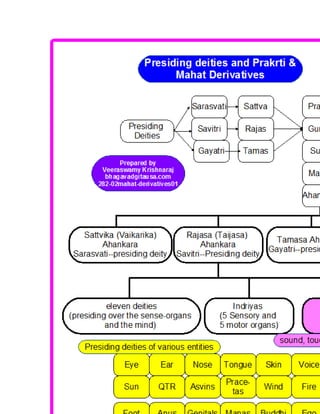
![The Cascade
Siva1, Sakti2, Sadasiva 3, Isvara4, Sadvidya5, MayA6, Kala7, Niyati8, Kala9,
Vidya10, Raga11, Purusa12 Prakrti Tattva13,
Buddhi14, Ahamkara15, Manas16, hearing--Ears17, touch--Skin18, vision and
color--Eyes19 , tasting--Tongue or mouth20, smell--Nose21, speech-Larynx22,
grasp-Hands23, ambulation--Feet24, evacuation--Anus25, procreation-
Genitals26, sound27, palpation28, form29, taste30 , odor31, ether32, air33, fire34,
water35, earth36.
Since all the elements in the cascade came from Siva-Sakti, all beings and all
the universes pulsate with Siva-Sakti. Beings and universes are Siva-Sakti.
Sakti is the second element in the cascade. So Siva is all.
Saiva Siddhanta believes that there is a chasm between Pure Consciousness of
Siva on one hand and Maya, Purusa, Tattvas, and matter on the other hand.
This chasm can be traversed by Sakti; there is no physical connection between
Siva and matter; all apparent connections are through the intermediation of
Sakti. Yes, He is Water, Air, Fire, Ether and Sky. Let me explain this apparent
contradiction. Siva has three levels of perfection: Supreme Siva1, Parasakti2and
Parameshvara3. Parameshvara3 has connection with matter through
Sakti. Supreme Siva1 is Atattva (Not THAT, not matter). Atattva is NOT
mutable, while Tattvas (matter) are mutable.
Supreme Siva, 1st perfection, The following are other epithets. SivaLinga,
Absolute Reality, Paramatman or Supreme Atman, Nirguna Brahman
(Brahman without attributes or ParaBrahman, Brahman without Parvati), A-
Tattva (Beyond Tattva), Niskalatattva = the Tattva without Kala or Prakriti.
Niskala (No Kala [parts] = No manifested Sakti), Niskriya (No action =
actionless), Asabda (No sound = beyond sound = unmanifest sound),
Amanaska (without Manas or mind), Nir-vikalpa Samadhi (absence of
differentiation; union; absorption, nondual state between Yogi and
Brahman). Siva is Niskala, meaning he has no parts, he is whole, he is
undivided, he is absolute or Nirguna Brahman--Brahman without attributes;
undifferentiated Brahman. As you see here, there is no connection between 1st
perfection and matter. Realized Yogis commune with Siva at this stage in
Nirvikalpa Samadhi.
Mind = that which is an internal organ of perception, volition, and
action. -- Monier-Williams
Horizontal relationship among other entities and sects](https://image.slidesharecdn.com/tattvas36google-160928121305/85/Tattvas-36-google-com-19-320.jpg)
![Nirguna Brahman = Supreme Narayana (Adhi Narayana) = Parasambhu Siva =
Brahmamayi (Here you get an instance where attributeless undifferentiated
Brahman becomes Clinical Brahman [Saguna Brahman, Brahman with
attributes] who can be any of the following depending on the sect of the
worshipper: Vishnu of Vaishnavas, Siva of Saivites, or Devi of Saktas
(worshippers of Mother Goddess.) Their common hierarchic superior is
genderless non-sectarian undifferentiated Para Brahman or Nirguna
Brahman. Vaishnavites do not believe in Brahman without attributes. Their
Parabrahman has attributes or Kalyana Gunas.
Parasakti: 2nd perfection = Supreme Sakti, Sakala (many forms; consisting
of parts as opposed to Niskala--no parts. kala = part), Saguna Brahman
(Brahman with attributes, Sabda Brahman or Sound Brahman (the One with
Thinkability and Speakability), Sakala Siva with attributes and actions, Saguna
Brahman with Maya Parvati), Sat-Chit-Ananda (Sachidananda, Being-
Consciousness-Bliss), Sa-vikalpa Samadhi (Duality between object and Subject
[Idam and Aham, Yogi and Brahman], differentiation.) KalA (கைா) has many
contextual meanings and for our purpose we use only a few: Learning, Parts,
Power, Digits of the moon.
Paramesvara: 3rd Perfection, Supreme Isvara or Controller of the
phenomenal world. Paramapurusa (Supreme Purusa), manifest Brahman --
clinical Brahman, Siva-Sakti. This is where Siva, who maintains the portfolio
of destruction, has connection with matter through Sakti.
The Supreme Paramasiva (Parabrahman Siva) lives in Satyaloka. Sambhu lives
in Maharloka. Sadasiva, Isa, Rudra, Vishnu, and Brahma, whose abodes are
Tapoloka, Janaloka, Svarloka, Bhuvarloka and Bhurloka, preside over the five
elements respectively: Earth, water, fire, air, and ether. Paramasiva is the
abiding place of all Devatas.
Here is the depiction of Perfections of Siva (1st, 2nd and 3rd) in a flowchart.
siva-hierarchy.gif is modified to siva-hierarchyA.jpg](https://image.slidesharecdn.com/tattvas36google-160928121305/85/Tattvas-36-google-com-20-320.jpg)
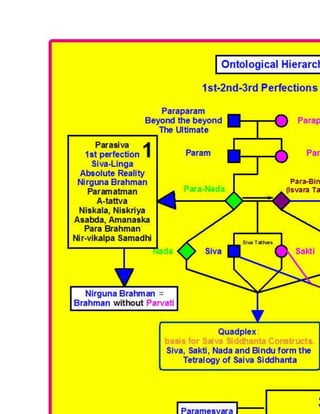





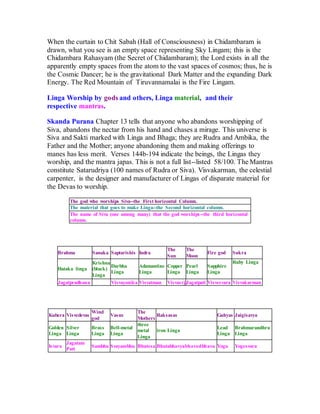


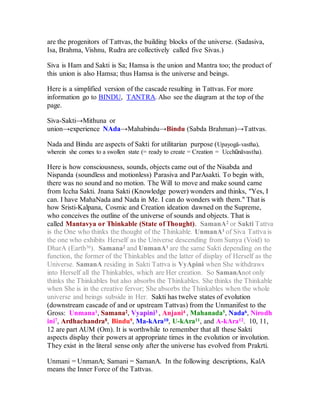
![When Unmani is disunited from Manas and devoid of all attachment to all worldly
things, it becomes Unmani1 Having reached Unmani, one does not return. Siva
Sutra Verse 3.8 says once he who attains oneness with Unmana, the world
appears as a ray of light. Dualism disappears for him.
Siva Sutra:
3.8. जाग्रद् द्वितीयकरः। jāgrad
dvitīyakaraḥ. जाग्रद् = jāgrad = awake; द्वितीय = dvitīya = the
second one; करः = karaḥ = ray (hand) He is awake to the fact that this world is
a ray of His light. Krishnaraj.
(He is) one who is always awake i.e. who is always at -one-ment with Unmanā and in
whom the world appears as his effulgence of light. Jaideva Singh.
Singh: having obtained the pure Vidya (UnmanA), and having obtained perfect
identification with it, he is ever awake (jagrat).
Being awake means remaining always in the state of UnmanA. Consciousness is the
hypostasis ofall manifestations. There is Saktiman, the possessorofSakti. Sakti is the
manifest world. This world is not mere This or Idam; but is a ray of His light.
Bhaskara says that the Jagrat, being Jnana Sakti, grasps by its hand the Universe as
non-different from Jnana.
NirvAna Sakti has two KalAs or Inner Force: NirvAna KalA and AmA
KalA, the 17th and 16th kalAs respectively. Nirvana Sakti is
both Unmani1andSamani2. Nirvana KalA is Vyapini3 or Sakti Svarupa and
above the 16th kala. Nirvana Sakti is the AntargatA (Indweller) of AmA KalA
which is the AntargatA (inner container) of Nirvana KalA. Ananda is the Bliss
or Joy which arises from the union of Para (Bindu-Rupa Siva) and ParA (Sakti
or Prakrti); from such union flows the nectar, of which AmA KalA is the
receptacle. --Woodroffe. AmA is the one that maintains the bodies. AmA is
also the Sakti (Urdhva Sakti-Rupa = Form of Sakti that moves [the soul]
upwards) who propels the soul towards (upwards to) Brahman. When man gets
liberated he (or she) moves from matter to spirit in upward fashion. As he
moves up, the matter drops one by one and the pure spirit goes up to merge
with Sakti and Siva.
In Pravrtti, beings and the world of objects are created. In Nivrrti, they come to
the source.](https://image.slidesharecdn.com/tattvas36google-160928121305/85/Tattvas-36-google-com-31-320.jpg)



